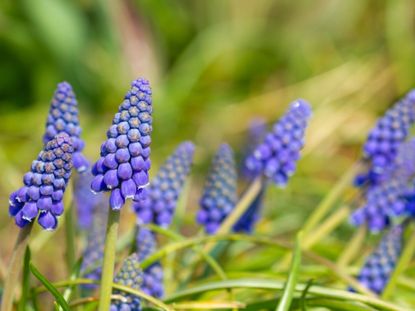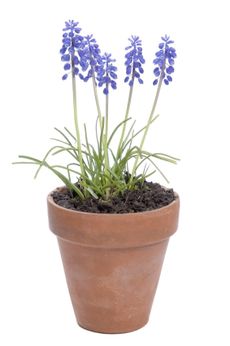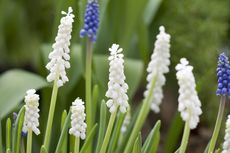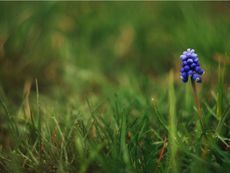Grape Hyacinth After Flowering – Learn About Muscari Care After Blooming


Grape hyacinth (Muscari armeniacum) is often the first bulb-type flower to show its blossoms in your garden in spring. The flowers look like clusters of little pearls, blue and white. They usually carry a mild fragrance. When the grape hyacinth blooming season comes to an end, you need to care for the bulbs to protect and preserve them so that they can bloom again the following year. Read on for information about Muscari care after blooming.
Post Bloom Grape Hyacinth Care
You really don’t want seeds to set on those grape hyacinth after flowering. The plant doesn’t need seeds and setting seeds depletes its energy supply. So that means grape hyacinth after flowering needs a trim. As soon as the flowers fade, trim them back with pruners or garden scissors. Remove the small flowers from the stem by running your fingers from just beneath the flower cluster to the tip of the blossom. However, leave the flower stem and do not cut it. It will provide nourishment for the bulb as long as it is green. For the same reasons, leave the foliage in place. This allows the leaves to continue to collect energy from the sun to feed the bulb for next year’s blooms. After grape hyacinth blooming season is at an end, the foliage eventually turns yellow and dies back. This happens about a month and a half after first blooming. At this point, the best post bloom grape hyacinth care requires that you clip back the stems to the ground.
What to Do with Muscari Bulbs after Flowering
You may wonder what to do with Muscari bulbs after flowering is over and the plant stems are cut back. Generally, all you have to do is apply a little manure over them in autumn, then a layer of mulch to keep the weeds down. Water them when the weather is dry. In some cases, Muscari care after blooming may include digging up the bulbs. If the plants show signs of overcrowding that limits their blooming, you can dig them up. Do this very carefully to avoid damaging any of the bulbs. Once you have the bulbs out of the ground, separate them and plant some of them in other parts of the garden.
Gardening tips, videos, info and more delivered right to your inbox!
Sign up for the Gardening Know How newsletter today and receive a free download of our most popular eBook "How to Grow Delicious Tomatoes."

Teo Spengler has been gardening for 30 years. She is a docent at the San Francisco Botanical Garden. Her passion is trees, 250 of which she has planted on her land in France.
-
 Urban Composting Guide: How To Compost In The Middle Of The City
Urban Composting Guide: How To Compost In The Middle Of The CityUrban composting does not have to be daunting. You can compost in the city, and maybe even try some urban worm composting!
By Mary Ellen Ellis
-
 Shrub Diseases And Pests To Watch Out For
Shrub Diseases And Pests To Watch Out ForShrub diseases and pests can be challenging. Learn how to recognize and eradicate them before they can present a danger to your plants.
By Susan Albert
-
 Feather Hyacinth Plants – Tips For Planting Feathered Grape Hyacinth Bulbs
Feather Hyacinth Plants – Tips For Planting Feathered Grape Hyacinth BulbsThe feather hyacinth, aka tassel hyacinth plant, can add another cool textural element to the garden with their feathery plumes. If you have some of these bulbs and are ready to go, click this article for tips on how to grow a Muscari feather hyacinth, including tips on their care.
By Teo Spengler
-
 Digging Grape Hyacinths: How To Store Hyacinth Bulbs After Flowering
Digging Grape Hyacinths: How To Store Hyacinth Bulbs After FloweringGrape hyacinths are easy to dig up after flowering. Can you replant grape hyacinths? Yes, you can. Use the following article to get all the info you need about how to store hyacinth bulbs after flowering. Click here to learn more.
By Teo Spengler
-
 Muscari Propagation: Learn About Propagating Grape Hyacinth Bulbs And Seeds
Muscari Propagation: Learn About Propagating Grape Hyacinth Bulbs And SeedsIf you want to start growing grape hyacinth, or want to expand your collection, propagating grape hyacinths is very easy. Click this article to learn about propagation from grape hyacinth bulbs and grape hyacinth seeds.
By Liz Baessler
-
 Growing Grape Hyacinth In Containers: How To Plant Muscari Bulbs In Pots
Growing Grape Hyacinth In Containers: How To Plant Muscari Bulbs In PotsGrape hyacinths are not, contrary to popular belief, related to hyacinths. They're actually a type of lily. They have a shockingly beautiful blue color (except when they're white) and a heavenly scent. They also grow very well in pots, and this article will help.
By Liz Baessler
-
 Types Of Grape Hyacinths: Grape Hyacinth Varieties For The Garden
Types Of Grape Hyacinths: Grape Hyacinth Varieties For The GardenThere are many grape hyacinth varieties, 40 species alone, that are resilient additions to the landscape mirroring the blue skies heralding winter's end. So what are grape hyacinth plants and what types of grape hyacinths are suited to your garden? Learn more here.
By Amy Grant
-
 Muscari Seed Planting: How To Grow Grape Hyacinth Flower Seeds
Muscari Seed Planting: How To Grow Grape Hyacinth Flower SeedsGrape hyacinth seed propagation is not as easy or quick as growing the plants from mature bulbs but it is an inexpensive way to further expand your stock of these appealing flowers. Click this article to learn more about Muscari seed planting.
By Bonnie L. Grant
-
 Caring For Grape Hyacinth In Lawns: How To Naturalize Grape Hyacinth Bulbs
Caring For Grape Hyacinth In Lawns: How To Naturalize Grape Hyacinth BulbsSome gardeners aren't crazy about the idea of grape hyacinths popping up in a tidy lawn, but others love the carefree appearance amid the grass. If you belong to the latter group, click here to learn how to naturalize grape hyacinth bulbs in your lawn.
By Mary H. Dyer
-
 Tassel Hyacinth Growing: Learn About Tassel Hyacinth Bulbs In The Garden
Tassel Hyacinth Growing: Learn About Tassel Hyacinth Bulbs In The GardenTassel hyacinth bulbs are considered a delicacy in Mediterranean countries where the plant is cultivated for this purpose. Read this article for more wild tassel hyacinth info, and learn how to take care of tassel hyacinths in your garden.
By Mary H. Dyer